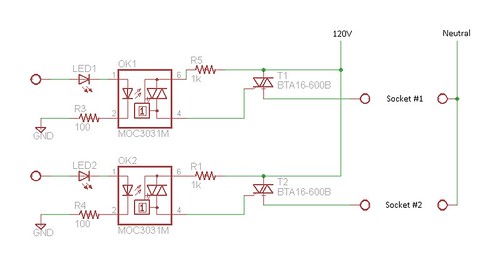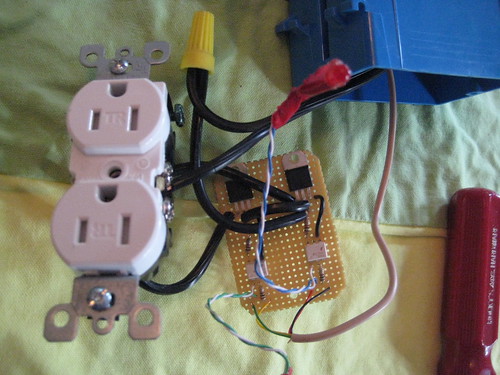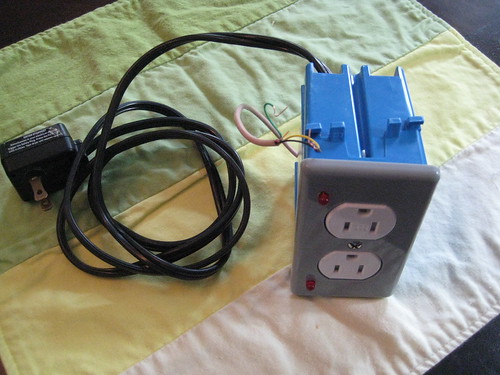A lot of my projects involve 120VAC, switching relatively slowly. Most people use mechanical relays in that situation, but I don’t like them; I try to avoid moving parts whenever possible. Up to this point, I’ve always used solid state relays. They work really well, but they’re expensive. What this means is that I’ve needed to move my same 2 SSRs from project to project, which is kind of a pain.
Well no more! Enter the humble Triac. They’re tiny, cheap, and in my slow switching applications the circuitry isn’t too complicated. That being said, it’s still the most complicated circuit I’ve ever attempted.
I figured a good first application would be a switched outlet. It’s fairly simple, and it’s something that I could use in prototyping later on.
And there you have it. A neat little package with two independently controlled power plugs. The best part is the cost. The whole thing cost less then $10! With SSRs it would have been ~$80, and I don’t know if they even would have fit in the box.
Triac Box from br3ttb on Vimeo.
There’s one issue I’m going to need to keep an eye on. Apparently, if a Triac overheats, it tends to fail into the on position. There’s nothing here that detects if this is about to happen, so I’ll have to keep an eye on it for a while to be sure there’s adequate cooling
Update: There is NOT adequate cooling. I did a real test just now. 1500W toaster oven on high. after a minute I started smelling perfboard. Everything was disconnected before any damage was done, but some design revisions are in order before I try to switch high loads again.
Tags: Triac







Consider this?
http://www.adafruit.com/index.php?main_page=product_info&products_id=268&zenid=03525d3fdb4df63f25808e477786ede5
yeah the powertail looks nice. it uses a relay though, which I have an aversion to. also, I’m getting two independently controlled plugs instead of one.
Typical voltage drop across a TO-220 triac is around 1.2-1.5V with greater loads tending more towards the 1.5V figure. With a 12A device such as a toaster oven, you end up with package dissipation of 14-18W.
The ThetaJ-A for an average TO-220 is 50-70C/Watt… Thus you can run 1 amp load without a heat sink and be reasonable safe in a room temperature ambient environment, where as a 12A load will vaporize the Triac and its surroundings in short order. The parts you chose must be pretty impressive that they withstood that amount of power for an entire minute.
Going backwards, assuming we want to run a 12A load, and thus handle 18W of package dissipation means we need a pretty good heat sink, probably to the tune of 2″x3″ aluminum extrusion with multiple fins. Life becomes even more difficult, if we want to put 2 triacs running 12A loads in an outlet box, as not only has the power dissipation doubled, but the base ambient temperature will be much much higher than room temperature.
SSR modules are likewise not the answer, as even if you could fit 2 of them in an outlet box, they will still create similar amounts of power which you need to get out of the box to keep their internal SCR’s happy.
What you are trying to do however is not impossible…. just mechanically difficult, and there are a multitude of trade-offs one needs to consider.